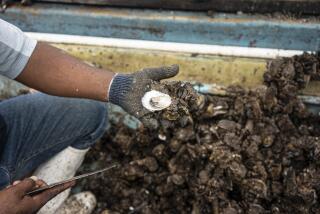Shell Disease Strikes 30% of New England Lobsters
- Share via
NARRAGANSETT, R.I. — A disease that rots lobsters’ shells and can kill the crustaceans affects 30% of lobsters along the New England coast, damaging the industry in many areas, scientists said Wednesday.
The disease’s cause and how it spreads remain a mystery, though theories are emerging, and the scientists said they would seek state and federal money for more studies.
The disease does not taint the lobsters’ meat but makes shells too unsightly to serve whole. It can weaken lobsters so much that some die prematurely.
Researchers in the region first noticed the disease in the 1980s, with shells marked by little black spots. But in recent years, the researchers said, shells have become fully enveloped by the disease and, in the worst cases, have rotted entirely.
Scientists said trawl and trap studies showed egg-carrying females were most susceptible to the disease. The studies also showed lobsters living in warmer waters appeared to contract the disease more readily.
Hans Laufer, a professor emeritus of molecular and cell biology at the University of Connecticut, said he believed lobsters might contract the disease from alkylphenols, chemicals that were byproducts from industrial sources. Laufer stressed his studies were preliminary.
In 1999, the lobster industry in Rhode Island generated $30 million and employed 425 fishermen, according to Mark Gibson of the state Department of Environmental Management. Four years later, the industry produced $16.7 million and employed 279.
More to Read
Sign up for Essential California
The most important California stories and recommendations in your inbox every morning.
You may occasionally receive promotional content from the Los Angeles Times.













